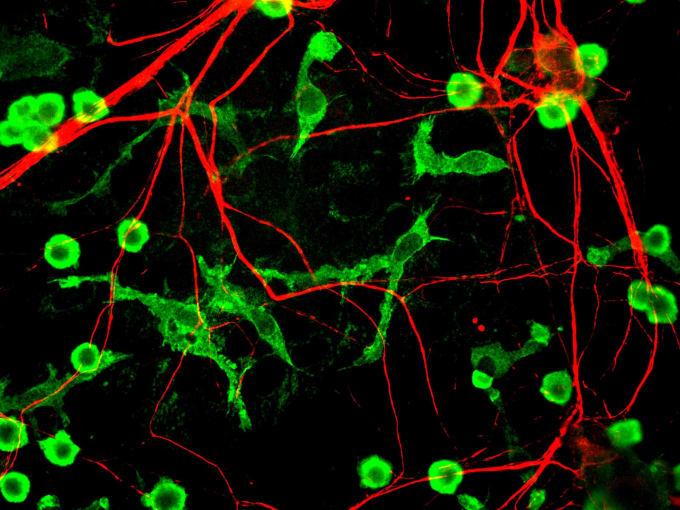The missing subtype: exploring microglial diversity in aging and Alzheimer’s disease
In the largest to date single cell study of whole, living microglia cells, a research team from Columbia University Medical Center discovered a curious reduction in the proportion of a distinct microglia subtype in the cortical tissues of Alzheimer’s disease patients. Learn how single cell gene expression analysis supported their investigation of microglial diversity and function in the aging human brain affected by neurodegenerative disease.

“The nomadic nature of microglia is best observed in neurodegenerative processes, during which the apparent rest they enjoyed in the normal state turns into migratory and phagocytic activity.”
Pío del Río-Hortega, discoverer of microglia in 1919 (1)
While neurons are the fundamental cellular building blocks of the brain—establishing the circuitry that allows us to think, move, and feel—they aren’t the only crucial players when it comes to neuronal health and function. Microglia, tissue-resident macrophages, serve as the immune sentinels of the central nervous system. They survey the neural environment in what is thought to be a non-inflammatory homeostatic state, looking for any sign of damage or danger (2). Their surveillance roles include monitoring the functional state of neuronal synapses and responding to tissue injury or disease through recognition of danger- and pathogen-associated molecular patterns, like the presence of viral DNA or neurodegenerative signals. Upon recognition of these enemies to neuronal health, microglia respond in a graded fashion by changing their transcriptional profile, morphology, and function to address the pathology, driving an inflammatory response or clearing diseased cells through phagocytosis (2). This protective response can, however, diminish as aging or neurodegenerative disease impair microglial activity, making these cells important targets for potential therapeutic development and investigation into the underlying mechanisms of neurodegeneration.
Single cell RNA-seq: a powerful tool for understanding microglial diversity
Augusto-Oliveira et al. remarked that “microglia respond differently to diverse pathological stimuli and change their behavior over the evolution of any given pathology in relation to different phagocytic activities and transcriptional profiles in different brain regions and at different ages” (2). The complexity of these triggers and subsequent cellular transformation of microglia suggests that a simplified classification of these cells as resting or activated, and as non-inflammatory or inflammatory, does not capture the full range of subtype identity or activity. This has prompted the characterization of microglial heterogeneity and function using next-generation sequencing tools, though with limited success to date because bulk sequencing cannot parse out specific microglial subtypes or their functions. Additionally, evidence suggests that single nuclei RNA-sequencing, though essential when working with frozen samples or large neuronal cell types, cannot always capture the full range of gene expression pertinent to refined microglial functional characterization, particularly in neurodegenerative disease (3).
For these reasons, a team of researchers led by Dr. Philip L. De Jager and Dr. Marta Olah from the Columbia University Medical Center decided to take a single cell approach to study microglia. They used cortical autopsy samples from 14 participants of the Memory and Aging Project and 3 samples removed surgically from patients with intractable epilepsy. After processing and sorting these samples to isolate live immune cells, they performed single cell RNA-sequencing, yielding individual transcriptomes for 16,242 cells. Of 14 distinct cell clusters identified, 9 were marked by microglia-enriched genes, including C1QA, C1QB, C1QC, and GPR34 (4).
Taking a closer look at the potential inter-relatedness of these microglial clusters, the investigators found that some clusters had closely related transcriptomic signatures, offering support for the proposition that microglial cells differentiate radially from a common cell fate into a number of distinct states. Cells from the most common clusters across sample types lacked distinct on-off transcription factors and cell-surface markers, suggesting these cells could represent a homeostatic microglial state. Further annotation of gene expression patterns across clusters revealed cluster-defining gene signatures and clues to each cluster’s functional identity. For example, one cluster was enriched in genes related to antigen presentation; two clusters featured genes related to anti-inflammatory responses; another cluster was enriched in genes from the interferon response signaling pathway; and another cluster was enriched in genes associated with the cell cycle, suggesting it may represent a pool of proliferating microglial cells (4). Together, these gene expression insights reflect a microglial population structure that can be used as a benchmark and further refined as neuroscientists pool data from more samples, across regions, age time points, and disease states.
Exploring microglial activity in Alzheimer’s disease
The research team next aimed to uncover the possible role of these microglial subtypes in neurodegenerative disease. Leveraging a curated list of disease-associated genes, including GWAS-identified risk genes for Alzheimer’s disease (AD), Parkinson’s, multiple sclerosis, and amyotrophic lateral sclerosis, they identified several clusters with patterns of enrichment for disease-associated genes. Of particular interest, one cluster, annotated as cluster 7, was highly enriched for genes previously identified in Aβ-plaque-associated microglia, also known as disease-associated microglia (DAM) genes (5), and genes pertinent to inflammatory demyelination and ischemia. Cluster 7 also showed higher expression of GWAS-identified AD susceptibility genes, such as TREM2. Cross-referencing a bulk RNA-seq dataset derived from human cortex samples of subjects diagnosed with AD or AD dementia, the team found that this cluster was the only microglial subtype whose gene signature was altered. Specifically, it appeared that these AD samples had reduced expression of this microglial signature.
To further investigate the activity of cluster 7 microglia in AD, the research team looked to in situ analysis of AD tissue samples. Leveraging 8 frontal cortex brain sections from AD dementia subjects and 11 controls, they stained the tissue samples to identify these microglia, which were previously indicated as IBA1+ CD74-high cells. This revealed a significant reduction in the frequency of IBA1+ CD74-high microglial cells in AD samples. To confirm this histological finding, the team reviewed a recent single nucleus RNA-seq dataset derived from the same brain region, aligning their microglia cluster-defining gene sets with those generated by single nucleus data. Most of the microglial clusters were replicated, and cluster 7 was again indicated to be reduced in frequency in AD samples. This points to a novel understanding of the activity of a specific microglial subtype in Alzheimer’s disease.
Sharing data to advance targeted microglial therapies
This study represents an important advancement in our understanding of the diversity and role of microglial cells in human disease. And it serves as a reference guide and springboard for further investigation into these crucial immune sentinels of the central nervous system, including the potential development of targeted microglial therapies for neurodegenerative diseases.
In the hopes that other scientists will take up this baton of studying microglial diversity and function, the authors have shared their single cell datasets at https://vmenon.shinyapps.io/microglia, and through the Synapse portal (https://www.synapse.org/#!Synapse: syn21438358).
For more information about the single cell RNA-sequencing tools used in this study, explore these resources. And find more helpful neuroscience content here.
References:
- Sierra A et al. Cien Años de Microglía: Milestones in a Century of Microglial Research. Trends in Neuro 42, 11: 778–792, 2019.
- Augusto-Oliveira M et al. What Do Microglia Really Do in Healthy Adult Brain? Cells 8, 10: 1293, 2019.
- Thrupp N et al. Single-Nucleus RNA-Seq Is Not Suitable for Detection of Microglial Activation Genes in Humans. Cell Rep 32, 13: 108189, 2020.
- Olah M et al. Single cell RNA sequencing of human microglia uncovers a subset associated with Alzheimer’s disease. Nat Comm 11, 6129, 2020.
- Butovsky O, Weiner HL. Microglial signatures and their role in health and disease. Nat Rev Neurosci 19, 10: 622–635, 2018.
